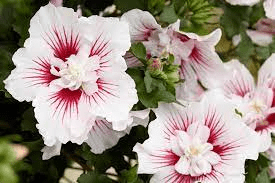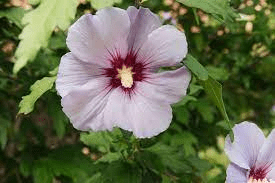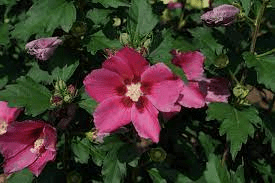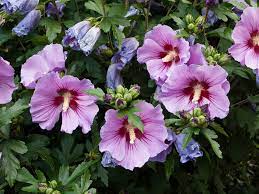Hibiscus syriacus, commonly known as Rose of Sharon, is a deciduous flowering shrub belonging to the Malvaceae family. Native to Asia, specifically China and India, this plant is known for its ornamental value and has been cultivated in various regions around the world.
The Rose of Sharon typically reaches a height of 8 to 12 feet and features lobed leaves with serrated edges. Its notable blooms, which appear in late summer to early fall, consist of large, showy flowers with a funnel-shaped structure.
These flowers vary in color and can be found in shades of white, pink, purple, or blue, often displaying a prominent central boss of stamens. The plant’s ability to produce a profusion of flowers makes it a popular choice for garden landscaping.
From a botanical perspective, Hibiscus syriacus exhibits the characteristics of woody shrubs, with a well-branched and upright growth habit. It is adaptable to a range of soil types and is generally hardy, tolerating different environmental conditions.
The Rose of Sharon is deciduous, shedding its leaves in the fall, and its seeds are encapsulated in a distinctive capsule.
In addition to its aesthetic appeal, Hibiscus syriacus has been studied for potential medicinal properties. Some cultures have used parts of the plant in traditional medicine for various purposes.
The plant is also known to attract pollinators, such as bees and butterflies, contributing to the ecological balance of its habitat.
The Botanical Description of Hibiscus syriacus
1. Upright Growth Habit: The botanical description of Hibiscus syriacus includes its characteristic upright growth habit, giving it a statuesque appearance in the landscape.
2. Deciduous Nature: As a deciduous shrub, Hibiscus syriacus sheds its leaves in the fall, contributing to the seasonal changes in its appearance.
3. Lobed and Serrated Leaves: The leaves of Hibiscus syriacus are medium green, lobed, and have a serrated edge, adding texture to the plant’s overall aesthetic.
4. Vibrant Trumpet-Shaped Flowers: The most distinctive feature is its trumpet-shaped flowers, characterized by five distinct petals that form an eye-catching display.
5. Diverse Color Palette: The flowers exhibit a diverse range of colors, including white, pink, purple, and blue, enhancing the visual appeal of the shrub.
6. Prolific Blooming: Known for its prolific blooming, Hibiscus syriacus graces the garden with an abundance of flowers from midsummer to fall.
7. Medium to Tall Height: Mature specimens of Rose of Sharon typically reach heights of 8 to 12 feet, providing a substantial presence in garden landscapes.
8. Central Staminal Column: The central staminal column in the flowers is a distinctive feature, contributing to the overall structure of the blossoms.
9. Attractive Fall Foliage: While deciduous, the Rose of Sharon doesn’t lose its charm in the fall, with leaves exhibiting warm autumnal hues before dropping.
10. Striking Visual Display: The combination of the shrub’s growth habit, foliage, and vibrant blossoms creates a striking visual display, making it a popular ornamental choice.
11. Tolerant to Pruning: Hibiscus syriacus responds well to pruning, allowing gardeners to shape and manage its size according to their preferences.
12. Adaptable to Various Soil Types: This hardy shrub is adaptable to different soil types, further contributing to its versatility in garden settings.
The Geographic Distribution of Hibiscus syriacus

Hibiscus syriacus, or Rose of Sharon, is native to East Asia but has found widespread cultivation in various regions around the world. Its adaptability to different climatic conditions has contributed to its popularity in diverse geographic locations.
1. Native to East Asia: The natural habitat of Hibiscus syriacus encompasses East Asian countries, including Korea, China, and India.
2. Cultivated Worldwide: Due to its ornamental value, Hibiscus syriacus has been cultivated extensively beyond its native range and can be found in gardens and landscapes across the globe.
3. Thrives in Temperate Climates: Rose of Sharon thrives in temperate climates, with regions featuring distinct seasons providing favorable conditions for its growth and blooming.
4. Suitable for USDA Zones 5-9: The geographic distribution of Hibiscus syriacus includes regions within USDA Hardiness Zones 5 to 9, where it adapts well to varying temperature ranges.
5. Common in North America: The plant has become a common sight in North American landscapes, with its hardiness making it well-suited to the climatic conditions of the continent.
6. Popular in European Gardens: Hibiscus syriacus has also gained popularity in European gardens, where its vibrant flowers contribute to the beauty of landscapes.
7. Adaptability to Different Soils: This shrub’s adaptability to different soil types allows it to thrive in various regions, provided the soil is well-draining.
8. Urban Landscapes: Rose of Sharon is frequently utilized in urban landscapes, parks, and residential gardens, enhancing the aesthetic appeal of these areas.
9. Coastal Areas: The plant’s tolerance to different environmental conditions extends to coastal areas, where it can withstand the challenges posed by salt-laden air.
10. Landscapes with Distinct Seasons: The geographic distribution of Hibiscus syriacus aligns with regions that experience distinct seasons, allowing it to showcase its deciduous nature and prolific blooming.
11. Human-Cultivated Landscapes: Beyond its natural habitats, the Rose of Sharon has become an integral part of human-cultivated landscapes, demonstrating its adaptability to diverse environments.
The Chemical Composition of Hibiscus syriacus
1. Anthocyanins: The vibrant colors of Hibiscus syriacus flowers, including shades of pink, purple, and blue, are attributed to anthocyanins, which are natural pigments.
2. Flavonoids: Flavonoids, including quercetin and kaempferol, are present in Hibiscus syriacus, contributing to its antioxidant properties.
3. Polyphenols: The plant contains polyphenolic compounds, which are known for their potential health benefits, including antioxidant and anti-inflammatory effects.
4. Tannins: Tannins, compounds with astringent properties, are found in Hibiscus syriacus and may contribute to its traditional uses.
5. Essential Oils: While not as prominent as in some other aromatic plants, Hibiscus syriacus does contain essential oils that contribute to its fragrance.
6. Organic Acids: Certain organic acids, such as citric acid and malic acid, are part of the chemical composition, influencing the plant’s taste and acidity.
7. Alkaloids: In trace amounts, alkaloids may be present, contributing to the overall chemical diversity of the plant.
8. Carotenoids: Carotenoids, responsible for yellow and orange pigments, may be present in specific varieties of Hibiscus syriacus.
9. Vitamins: While not a rich source, Hibiscus syriacus may contain small amounts of vitamins, contributing to its overall nutritional profile.
10. Minerals: The plant’s chemical composition includes minerals such as calcium, magnesium, and potassium, providing essential nutrients.
11. Proteins and Amino Acids: Proteins and amino acids are part of the chemical makeup, contributing to the overall nutritional content.
12. Sugars: Hibiscus syriacus contains sugars, providing a source of energy for the plant and potentially influencing its taste.
13. Lignans: These compounds, found in some hibiscus species, may have antioxidant properties and contribute to the plant’s overall chemical complexity.
14. Resins: Resins, with their sticky and protective nature, may be present in the chemical composition, contributing to the plant’s resilience.
Read Also: Complete Guide on How to Grow and Harvest Barley
The Medicinal Health Benefits Of Hibiscus syriacus (Rose of Sharon)

1. Antioxidant Properties: The presence of flavonoids and polyphenols imparts antioxidant properties to Hibiscus syriacus. Antioxidants help neutralize free radicals in the body, contributing to overall health.
2. Immune System Support: Compounds found in Hibiscus syriacus may contribute to immune system support, helping the body defend against infections and illnesses.
3. Anti-Inflammatory Effects: Some components in the plant may exhibit anti-inflammatory effects, potentially assisting in the management of inflammatory conditions.
4. Respiratory Health: Traditional uses of Rose of Sharon include remedies for respiratory issues. Its potential expectorant properties may aid in addressing coughs and congestion.
5. Digestive Aid: In traditional medicine, Hibiscus syriacus has been used as a digestive aid. Its mild laxative properties may contribute to digestive health.
6. Cardiovascular Support: Preliminary studies suggest that Hibiscus syriacus may have cardiovascular benefits, such as helping to regulate blood pressure and cholesterol levels.
7. Skin Conditions: External applications of Rose of Sharon extracts may be used for certain skin conditions due to its potential anti-inflammatory and soothing effects.
8. Menstrual Health: In traditional medicine, Hibiscus syriacus has been used to address certain menstrual issues. Its potential hormonal regulatory effects may play a role in supporting menstrual health.
9. Anxiety and Stress Relief: The plant’s calming properties may contribute to anxiety and stress relief, making it a potential component in herbal remedies for relaxation.
10. Rich in Vitamins: While not a primary source, Hibiscus syriacus contains vitamins, contributing to its overall nutritional profile and potential health benefits.
11. Hydration Support: As an infusion or tea, Rose of Sharon can contribute to hydration, offering a flavorful and health-conscious beverage option.
12. Traditional Wound Healing: External applications of Hibiscus syriacus extracts have been traditionally used for wound healing due to its potential antimicrobial and anti-inflammatory effects.
13. Metabolic Support: Some compounds in the plant may offer metabolic support, potentially playing a role in weight management and overall metabolic health.
14. Mild Analgesic Properties: Traditional uses include Hibiscus syriacus for mild pain relief. Its potential analgesic properties may be beneficial in addressing minor aches and pains.
15. Hormonal Balance: While further research is needed, some traditional uses suggest that Hibiscus syriacus may play a role in hormonal balance, particularly in women’s health.
16. Kidney Health: Traditional practices involve the use of Hibiscus syriacus for kidney health, with potential diuretic effects contributing to urinary system support.
17. Overall Well-Being: The combination of its potential health-promoting properties contributes to the overall well-being of individuals incorporating Hibiscus syriacus into their wellness routines.
The Methods of Usage to Achieve the Provided Health Benefits Of Hibiscus syriacus (Rose of Sharon)
1. Herbal Infusions: One of the most common methods is preparing herbal infusions or teas using dried Hibiscus syriacus flowers. This allows for the extraction of beneficial compounds for overall health support.
2. Tinctures: Creating tinctures involves extracting the plant’s medicinal properties using alcohol or another solvent. Tinctures offer a concentrated form that can be diluted in water for consumption.
3. External Compresses: For skin-related benefits, creating external compresses using Hibiscus syriacus extracts can be applied to affected areas for potential anti-inflammatory and soothing effects.
4. Culinary Uses: Incorporating dried Hibiscus syriacus petals into culinary creations adds not only visual appeal but also potential health benefits. Petals can be used in salads, desserts, or as a garnish.
5. Dietary Supplements: In the form of capsules or powders, Hibiscus syriacus can be consumed as a dietary supplement. This method offers a convenient way to integrate its health-promoting properties into daily routines.
6. Aromatic Bath Additives: Adding dried Hibiscus syriacus petals or essential oil extracts to bathwater creates an aromatic and potentially soothing experience, contributing to relaxation and skin benefits.
7. Herbal Smoking Blends: While less common, dried Hibiscus syriacus petals can be included in herbal smoking blends for those who prefer this method. Caution is advised due to potential health risks associated with smoking.
8. Infused Oils: Creating infused oils using Hibiscus syriacus allows for external applications. These oils can be used topically for potential skin benefits or as massage oils.
9. Syrups and Elixirs: Infusing the plant into syrups or elixirs provides a sweet and flavorful way to consume Hibiscus syriacus, making it more palatable for those who may not enjoy the taste of herbal teas.
10. Cosmetic Products: Extracts from Hibiscus syriacus are incorporated into cosmetic products, such as creams and lotions, for potential skin benefits, including hydration and anti-aging effects.
11. Culinary Pairings: Utilizing dried petals in various culinary creations, such as sauces, jams, or beverages, allows for the integration of Hibiscus syriacus into daily diets.
12. Blended Herbal Teas: Combining dried Hibiscus syriacus petals with other complementary herbs creates blended herbal teas with a well-rounded flavor profile and enhanced health benefits.
The Side Effects Of Using Hibiscus syriacus Medicinal Plant
1. Allergic Reactions: Individuals with known allergies to plants in the Malvaceae family, including hibiscus species, may experience allergic reactions. Symptoms can range from mild skin irritation to more severe reactions.
2. Interactions with Medications: Hibiscus syriacus may interact with certain medications, including antihypertensive drugs. Consultation with healthcare professionals is advisable, especially for individuals taking blood pressure medications, to ensure there are no adverse interactions.
3. Potential Diuretic Effects: Due to its diuretic properties, excessive consumption of Hibiscus syriacus may lead to increased urination. Individuals with kidney issues or those taking diuretic medications should exercise caution.
4. Gastrointestinal Discomfort: In some cases, Hibiscus syriacus may cause mild gastrointestinal discomfort, including stomach cramps or nausea. This is more likely to occur with excessive consumption.
5. Blood Pressure Regulation: While it has shown potential benefits in supporting cardiovascular health, individuals with already low blood pressure should monitor their levels, as Hibiscus syriacus may contribute to further lowering.
6. Pregnancy and Breastfeeding: Pregnant and breastfeeding women should exercise caution and consult healthcare professionals before using Hibiscus syriacus medicinally. Limited studies exist on its safety during these periods.
7. Sedative Effects: Individuals using Hibiscus syriacus for its calming properties should be aware of potential sedative effects. It may cause drowsiness, and activities requiring alertness should be approached with caution.
8. Photosensitivity: Some individuals may experience increased sensitivity to sunlight after consuming Hibiscus syriacus. Sun protection measures should be taken to avoid skin irritation or sunburn.
9. Oxalate Content: Hibiscus syriacus contains oxalates, which, when consumed in excessive amounts, may contribute to kidney stone formation in susceptible individuals. Those with a history of kidney stones should monitor their oxalate intake.
10. Prolonged Use Concerns: While moderate and occasional use is generally considered safe, prolonged and excessive use of Hibiscus syriacus, especially in concentrated forms, may lead to cumulative effects. Periodic breaks are recommended.
11. Effects on Blood Sugar Levels: Individuals with diabetes should monitor their blood sugar levels when incorporating Hibiscus syriacus into their routine, as it may have blood sugar-lowering effects.
12. Potential Respiratory Issues: In some cases, individuals with respiratory conditions may experience irritation or allergic reactions when inhaling the pollen or dust from Hibiscus syriacus flowers.
13. Impact on Hormonal Conditions: Due to limited research, individuals with hormonal conditions should exercise caution, especially considering the potential hormonal effects of Hibiscus syriacus.
14. Not Recommended for Children: The safety of Hibiscus syriacus for infants and young children is not well-established. It is generally recommended to avoid its use in this age group.
15. Quality of Plant Material: The quality of the Hibiscus syriacus plant material, including dried flowers or extracts, can impact its safety. Purchasing from reputable sources and ensuring proper processing is essential.
16. Adherence to Dosages: Adhering to recommended dosages is crucial to minimizing potential side effects. Exceeding suggested amounts may increase the likelihood of adverse reactions.
17. Individual Sensitivities: Individuals vary in their sensitivities, and what may be well-tolerated by one person could cause discomfort in another. It’s advisable to start with small amounts and monitor individual responses.
Read Also: 20 Medicinal Health Benefits Of Bursera graveolens (Palo Santo)
The Scientific Research and Studies of Hibiscus syriacus

1. Antioxidant and Anti-Inflammatory Properties: Studies suggest that Hibiscus syriacus exhibits antioxidant and anti-inflammatory properties, attributed to its flavonoid and polyphenol content.
2. Cardiovascular Health: Research indicates that Hibiscus syriacus may contribute to cardiovascular health by helping to regulate blood pressure and cholesterol levels.
3. Anti-Microbial Effects: Some studies have explored the anti-microbial effects of Hibiscus syriacus, suggesting its potential role in addressing certain infections.
4. Diuretic Effects: Due to its diuretic properties, research has investigated the potential diuretic effects of Hibiscus syriacus, which may have implications for kidney health.
5. Traditional Uses Validation: Scientific studies have aimed to validate the traditional uses of Hibiscus syriacus, including its applications in respiratory health, digestive support, and wound healing.
6. Hormonal Regulatory Effects: Limited studies suggest that Hibiscus syriacus may have hormonal regulatory effects, particularly in the context of women’s health and menstrual issues.
7. Metabolic Benefits: Research has explored the metabolic benefits of Hibiscus syriacus, suggesting its potential role in supporting weight management and overall metabolic health.
The Safety Precautions and Recommendations In Using Hibiscus syriacus Medicinal Plant
1. Allergy Screening: Individuals with known allergies to plants in the Malvaceae family should undergo allergy screening before using Hibiscus syriacus.
2. Consultation with Healthcare Professionals: Pregnant and breastfeeding women, individuals with existing medical conditions, and those taking medications should consult healthcare professionals before using Hibiscus syriacus medicinally.
3. Moderate Consumption: To avoid potential side effects, it’s advisable to consume Hibiscus syriacus in moderation. Excessive intake, especially in concentrated forms, may lead to adverse reactions.
4. Quality Sourcing: Ensure that Hibiscus syriacus products are sourced from reputable suppliers. Quality control measures help mitigate the risk of contamination and ensure product safety.
5. Monitoring for Adverse Effects: Individuals using Hibiscus syriacus for medicinal purposes should monitor for any adverse effects. Discontinue use and seek medical attention if unexpected reactions occur.
6. Avoiding Prolonged Use: Prolonged and excessive use of Hibiscus syriacus, particularly in medicinal forms, should be avoided. Periodic breaks in usage can help prevent potential side effects.
7. Educating Consumers: Health practitioners and herbalists should educate consumers about the potential risks and benefits of using Hibiscus syriacus. This empowers individuals to make informed decisions about its inclusion in their health routines.
8. Different Forms of Consumption: Depending on the health concern, individuals can explore various forms of Hibiscus syriacus consumption, such as herbal teas, tinctures, or topical applications.
9. Avoiding in Specific Populations: Hibiscus syriacus may not be suitable for infants, young children, or individuals with specific health conditions. In such cases, it’s recommended to avoid its use altogether.
10. Product Labeling: Manufacturers of Hibiscus syriacus products should provide clear and accurate labeling, including information about proper usage, potential side effects, and recommended dosages.
11. Regulatory Compliance: Adherence to regulatory guidelines ensures that Hibiscus syriacus products meet safety standards. Both producers and consumers should be aware of and comply with relevant regulations.
12. Integrating with Professional Guidance: Individuals considering the use of Hibiscus syriacus for medicinal purposes should integrate it into their health routines under the guidance of qualified healthcare professionals or herbalists.
FAQs About Hibiscus syriacus Medicinal Plant
1. Is Hibiscus syriacus Safe for Regular Consumption?
Yes, when consumed in moderation, Hibiscus syriacus is generally considered safe for regular consumption. However, individuals with allergies, specific health conditions, or those taking medications should consult healthcare professionals before incorporating it into their routines.
2. Can Pregnant Women Use Hibiscus syriacus?
Pregnant women should consult healthcare professionals before using Hibiscus syriacus medicinally. Limited studies exist on its safety during pregnancy, and professional guidance is advisable.
3. How Does Hibiscus syriacus Support Cardiovascular Health?
Hibiscus syriacus may support cardiovascular health by helping regulate blood pressure and cholesterol levels. Its antioxidant and anti-inflammatory properties contribute to overall heart health.
4. Are There Specific Precautions for Individuals with Low Blood Pressure?
Yes, individuals with already low blood pressure should monitor their levels when using Hibiscus syriacus, as it may contribute to further lowering. Regular blood pressure checks are recommended.
5. Can Children Safely Consume Hibiscus syriacus?
The safety of Hibiscus syriacus for infants and young children is not well-established. It’s generally recommended to avoid its use in this age group unless under the guidance of healthcare professionals.
6. Are There Alternatives for Individuals Allergic to Hibiscus syriacus?
Individuals allergic to Hibiscus syriacus can explore alternative herbs for similar purposes. It’s crucial to undergo allergy screening and consult healthcare professionals for personalized recommendations.
7. Can Hibiscus syriacus Be Used for Skin Conditions?
External applications of Hibiscus syriacus extracts may be used for certain skin conditions due to its potential anti-inflammatory and soothing effects. Patch testing is advisable for individuals with sensitive skin.
8. What Are the Different Forms of Consuming Hibiscus syriacus?
Hibiscus syriacus can be consumed in various forms, including herbal teas, tinctures, dietary supplements, culinary uses, infused oils, and cosmetic products. The choice depends on individual preferences and health goals.
9. Does Hibiscus syriacus Interact with Medications?
Hibiscus syriacus may interact with certain medications, including antihypertensive drugs. It’s crucial to consult healthcare professionals, especially for individuals taking medications regularly.
10. Can Hibiscus syriacus Be Used for Hormonal Balance?
Limited studies suggest that Hibiscus syriacus may have hormonal regulatory effects, particularly in women’s health and menstrual issues. However, more research is needed to establish conclusive evidence.
11. Is Hibiscus syriacus Safe for Individuals with Diabetes?
Individuals with diabetes should monitor their blood sugar levels when using Hibiscus syriacus, as it may have blood sugar-lowering effects. Professional guidance is advisable for those managing diabetes.
12. How Can Hibiscus syriacus Be Integrated into Daily Diets?
Dried petals of Hibiscus syriacus can be integrated into various culinary creations, such as salads, desserts, sauces, or beverages. This adds both visual appeal and potential health benefits to daily diets.
13. What Precautions Should Be Taken for External Applications?
For external applications, such as compresses or infused oils, patch testing is advisable to check for any skin reactions. Individuals with sensitive skin should dilute extracts before use.
14. Can Hibiscus syriacus Be Used for Stress Relief?
The calming properties of Hibiscus syriacus may contribute to stress relief. However, individuals using it for this purpose should be aware of potential sedative effects and should avoid activities requiring alertness.
15. How Does Hibiscus syriacus Contribute to Overall Well-Being?
The combination of potential antioxidant, anti-inflammatory, immune-supporting, and other health-promoting properties contributes to the overall well-being of individuals incorporating Hibiscus syriacus into their wellness routines.
Read Also: Gazania Care 101: How to Keep Your Garden Blooming

